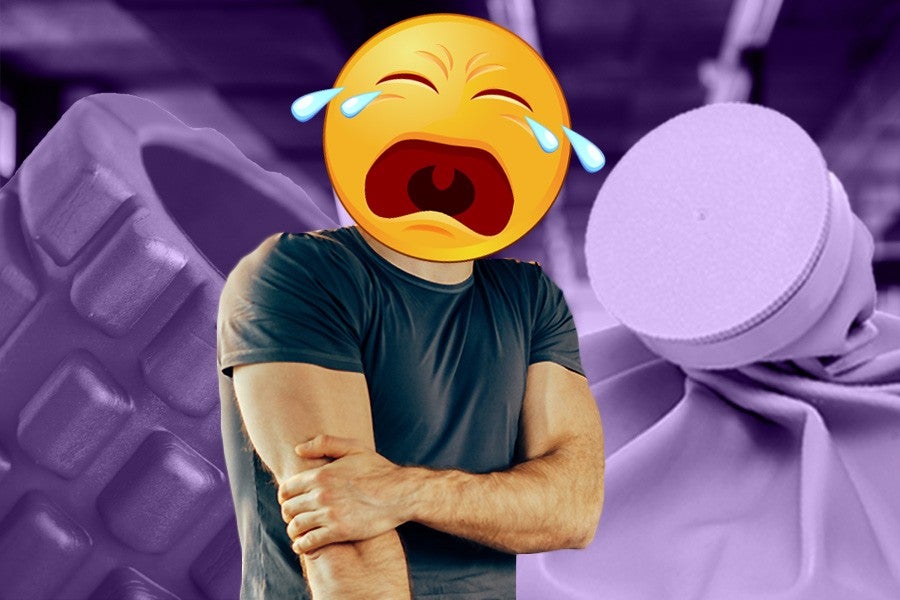It’s a new year, and chances are, you’re like the millions of other people around the world dedicated to finally getting, like, totally ripped, brah. What this means in practical terms is that, if you’re like me and haven’t worked out since fourth-grade gym class, you’re going to be hurting in a lot of new and interesting places this month.
But what kind of pain does your journey to You 2.0 (or 1.1) have in store? Jonathan Jordan, an award-winning trainer, explains how each type of workout will hurt, and how to heal more quickly.
Running
Where You’ll Hurt: “The most painful thing some people are prone to when they first start running is shin splints on the front of their legs, which is basically a catch-all name for lower leg pain that occurs below the knee either on the front outside part of the leg [anterior shin splints] or the inside of the leg [medial shin splints],” says Jordan. “Also lower back pain, particularly in people who have desk jobs and whose glutes and cores are pretty weak.”
Why: “If you go for a run without properly activating your glutes and your core, you’re going to arch and hurt your lower back,” explains Jordan. “There can be a number of factors at work that cause shin splints, such as inadequate stretching, worn shoes or excessive stress placed on one leg or hip from running on cambered roads, or always running in the same direction on a track.”
How to Soothe the Pain: “Gentle foam rolling — which is basically a gentle-to-deep intensity self massage, using a foam roller in order to release the fascia and muscles so your joints can move in their proper range of motion — is best,” explains Jordan. “Also making sure that you’re sleeping enough and taking a break from the activity that’s causing the pain. You could also use gentle heat and gentle ice. Personally though, I like an epsom salt bath that will help improve blood flow.”
Lifting Weights
Where You’ll Hurt: “If you’re doing pull-ups, you’re going to be sore in your armpits (lats),” says Jordan. “If you’re using the bench press, you’ll be sore in your bicep and triceps. For deadlifts, you’ll be sore in your hamstrings and your glutes, and if you’re squatting, you’ll be sore in quads and glutes.”
Why: “Any time you pick up a new movement — whether it’s lifting weights, doing squats or using the bench press — you’re going to be sore,” Jordan explains. “Even a seasoned weightlifter will be sore when picking up a new movement, because their muscles aren’t used to certain body rotations.”
How to Soothe the Pain: “Again, gentle foam rolling will help,” says Jordan. “When you’re foam rolling, there’s no need to feel pain. You could also take some supplements like fish oil, which reduces soreness, or branched-chain amino acids, which account for 35 percent of the essential amino acids in muscle proteins, will help with healing of muscle.”
Swimming
Where You’ll Hurt: “You’ll be hurting in your lower back,” says Jordan. “But in swimming, your most dominant muscle are your lats, so make sure you warm up your shoulders before you swim.”
Why: “If you arch your back or over-flex your neck while swimming, you may hurt your lower back,” says Jordan. “And since most people these days spend hours on their computer, this position in turn causes the shoulders to be internally rotated for the majority of the day. Your movements when you’re swimming require an external rotation. Those muscles, your chest and lats are going to be tight and they’re going to inhibit your ability to externally rotate your shoulders which is required for swimming.”
How to Soothe the Pain: “Foam rolling your lats and lower back is the best thing,” offers Jordan.
Elliptical
Where You’ll Hurt: “You’ll experience most of your pain in your knees,” Jordan says.
Why: “The way most ellipticals work is that they lock your knees in a position, and that strains your knee,” Jordan explains. “If you switch to an arc trainer, that will help minimize the abrasive horizontal force pushing down on the front of your knee.”
How to Soothe the Pain: Jordan says the best way to ease the pain is with rest, 30 minutes of ice on and off three times a day, compression or wrapping the sore area for 24 hours, and elevating that area to a position somewhere above your heart.
CrossFit
Where You’ll Hurt: “Everywhere,” says Jordan.
Why: “It’s a total body workout,” Jordan explains. “Every major muscle group will be hit. The workouts are explosive, highly metabolic. These are Olympic lifts.”
How to Soothe the Pain: “Branch amino acids and fish oils,” says Jordan. “Most importantly, though, you’ll need to give your body time to recuperate. If you’re new to CrossFit, please don’t do it two days in a row. That’s how you get injured.”

